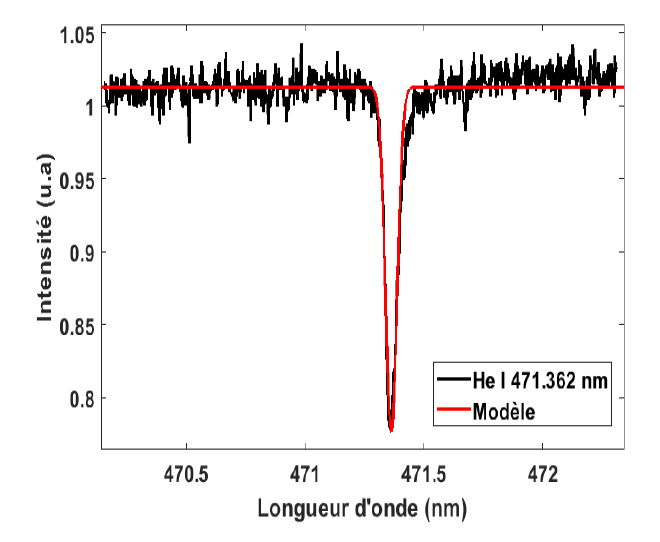Exploitation du spectre de l’étoile HD149382 : approximation des paramètres physiques par une technique d’analyse spectrale
- Post by: SOAPHYS-KZ
- 14 février 2021
- Comments off

http://dx.doi.org/10.46411/jpsoaphys.2020.01.12
Section de la parution: Information de publication
J. P. Soaphys, Vol 2, N°1 (2020) C20A12 ,14 Fevrier 2021
Pages : C20A12-1 à C20A12-6
Information sur les auteurs
Affiliation
1 Laboratoire de Physique et de Chimie de l’Environnement, Université Joseph KI-ZERBO, Ouagadougou, Burkina Faso
*To whom correspondances should be addressed. E-mail: fabricebado726@gmail.com
Abstract
The determination of physical parameters such as effective temperature, surface gravity, luminosity, and radius of a star requires an adequate analysis of its spectroscopic readings. In this paper, the main aim is to determine the physical parameters of the star HD149382 from its spectrum. Our indirect method consists in determining the half-height width of the profiles of the He I λ471.362 nm, He I λ501.605 nm, et He I λ667.872 nm lines which have a bell-shaped profile and which result from the radiative life within the star and the lifetime of the particles after collisions. We use a Gaussian curve for helium line modeling. This modeling consists first in extracting the considered lines and modeling them from the Matlab software. Our method is mainly based on the determination of the effective temperature, the radius, the surface gravity and the luminosity of the star HD149382 by Doppler Effect thanks to the half-height width of the Gaussian profile of the modeled absorption line. The results obtained show that the effective temperature, the surface gravity, the luminosity, and the radius have values ranging respectively between 33 427-40 051.7 K, 4.979-6.764 cm.s-2, 86.821-86.675 erg/K3/s et 3.34 Rʘ -10 Rʘ and that the star HD149382 is a dwarf star of sdB type.
Keywords : HD149382 ; Indirect method ; Physical parameters
Résumé
La détermination des paramètres physiques tels que la température effective, la gravité de surface, la luminosité, et le rayon d’une étoile nécessite une analyse adéquate de ses relevés spectroscopiques. Dans cet article, l’objectif est de déterminer ses paramètres physiques pour l’étoile HD149382 à partir de son spectre. Notre méthode indirecte consiste à déterminer la largeur à mi-hauteur des profils des raies He I λ471.362 nm, He I λ501.605 nm, et He I λ667.872 nm qui présentent un profil en cloche et qui résultent de la vie radiative au sein de l’étoile et de la durée de vie des particules suite aux collisions. Nous utilisons une courbe de Gauss (Gaussienne) pour la modélisation des raies de l’hélium. Cette modélisation à consister dans un premier temps à extraire les raies considérées et à les modéliser à partir du logiciel Matlab. Notre méthode est principalement basée sur la détermination de la température effective, le rayon, la gravité de surface et la luminosité de l’étoile HD149382 par effet Doppler grâce à la largeur à mi-hauteur du profil Gaussien de la raie d’absorption modélisée. Les résultats obtenus montrent que la température effective, la gravité de surface, la luminosité, et le rayon ont des valeurs comprises respectivement entre 33 427-40 051.7 K, 4.979-6.764 cm.s-2, 86.821-86.675 erg/K3/s et 3.34 Rʘ -10 Rʘ et que l’étoile HD149382 est une étoile naine de type sdB.
Mots clés : HD149382 ; Méthode indirecte ; Paramètres physiques
| [1] R. Aznar Cuadrado et C. S. Jeffery, « Physical parameters of sdB stars from spectral energy distributions », Astron. Astrophys., vol. 368, no 3, p. 994-1005, mars 2001, doi: 10.1051/0004-6361:20010068. https://doi.org/10.1051/0004-6361:20010068 |
||||
| [2] A. U. Landolt, « UBVRI photometric standard stars around the celestial equator: updates and additions », Astron. J., vol. 137, no 5, p. 4186-4269, mai 2009, doi: 10.1088/0004-6256/137/5/4186. https://doi.org/10.1088/0004-6256/137/5/4186 |
||||
| [3] Gaia Collaboration et al., « Gaia Data Release 2: Summary of the contents and survey properties », Astron. Astrophys., vol. 616, p. A1, août 2018, doi: 10.1051/0004-6361/201833051. https://doi.org/10.1051/0004-6361/201833051 |
||||
| [4] S. Geier, H. Edelmann, U. Heber, et L. Morales-Rueda, « Discovery of a close substellar companion to the hot subdwarf star hd 149382-the decisive influence of substellar objects on late stellar evolution », Astrophys. J., vol. 702, no 1, p. L96-L99, sept. 2009, doi: 10.1088/0004-637X/702/1/L96. https://doi.org/10.1088/0004-637X/702/1/L96 |
||||
| [5] U. Heber, « The atmosphere of subluminous B stars. II. Analysis of 10 helium poor subdwarfs and the birthrate of sdB stars. », \aap, vol. 155, p. 33-45, janv. 2086. | ||||
| [6] G. Michaud, G. Alecian, et J. Richer, Atomic Diffusion in Stars, 1st ed. 2015. Cham: Springer International Publishing: Imprint: Springer, 2015. https://doi.org/10.1007/978-3-319-19854-5 |
||||
| [7] U. Heber, « Hot Subdwarf Stars », Annu. Rev. Astron. Astrophys., vol. 47, no 1, p. 211-251, sept. 2009, doi: 10.1146/annurev-astro-082708-101836. https://doi.org/10.1146/annurev-astro-082708-101836 |
||||
| [8] I. Kafando, F. LeBlanc, et C. Robert, « Detailed abundance analysis of five field blue horizontal-branch stars », Mon. Not. R. Astron. Soc., vol. 459, no 1, p. 871-879, juin 2016, doi: 10.1093/mnras/stw653. https://doi.org/10.1093/mnras/stw653 |
||||
| [9] U. Heber, « Hot Subluminous Stars », Publ. Astron. Soc. Pac., vol. 128, no 966, p. 082001, août 2016, doi: 10.1088/1538-3873/128/966/082001. https://doi.org/10.1088/1538-3873/128/966/082001 |
||||
| [10] E. Niemczura, B. Smalley, et W. Pych, Éd., Determination of Atmospheric Parameters of B-, A-, F- and G-Type Stars: Lectures from the School of Spectroscopic Data Analyses, 1st ed. 2014. Cham: Springer International Publishing: Imprint: Springer, 2014. https://doi.org/10.1007/978-3-319-06956-2 |
||||
| [11] J.-F. Donati, « ESPaDOnS: An Echelle SpectroPolarimetric Device for the Observation of Stars at CFHT », in Solar Polarization, janv. 2003, vol. 307, p. 41. | ||||
| [12] J.-F. Donati, C. Catala, J. D. Landstreet, et P. Petit, « ESPaDOnS: The New Generation Stellar Spectro-Polarimeter. Performances and First Results », in Solar Polarization 4, déc. 2006, vol. 358, p. 362. | ||||
| [13] B. Baschek et J. Norris, « The OB-type subdwarf HD 149382 and the nature of the subdwarf B stars », Astrophys. J., vol. 209, p. 694, août 2075, doi: 10.1086/153739. https://doi.org/10.1086/153739 |
||||
| [14] B. Baschek, P. Hoeflich, et M. Scholz, « The OB subdwarf Feige 66, a chemical-composition twin to HD 149382. », \aap, vol. 112, p. 76-82, août 2082. | ||||
| [15] T. Lisker, U. Heber, R. Napiwotzki, N. Christlieb, D. Reimers, et D. Homeier, « Spectroscopic analysis of sdB stars from the ESO Supernova Ia Progenitor Survey », Astrophys. Space Sci., vol. 291, no 3, p. 351-358, 2004, doi: 10.1023/B.ASTR.0000044343.94946.51. https://doi.org/10.1023/B:ASTR.0000044343.94946.51 |
||||
| [16] U. Heber, K. Hunger, R. P. Kudritzki, et K. P. Simon, « NLTE analysis of SDO stars », Symp. – Int. Astron. Union, vol. 105, p. 215-218, 2084, doi: 10.1017/S0074180900030916. https://doi.org/10.1017/S0074180900030916 |
||||





